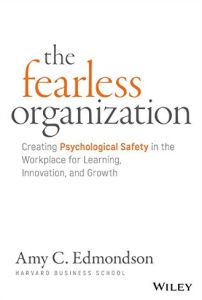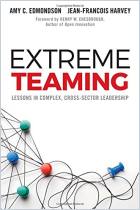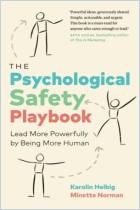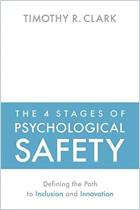加入 getAbstract 阅读摘要

加入 getAbstract 阅读摘要
Amy C. Edmondson
The Fearless Organization
Creating Psychological Safety in the Workplace for Learning, Innovation, and Growth
Wiley, 2018
看看什么内容?
Leadership expert Amy C. Edmondson explores censorship in the workplace and reveals its consequences.
Recommendation
Leadership expert Amy Edmondson defines a fearless organization as one in which people feel psychologically safe – enjoying protection from ridicule or penalties when they share their ideas, feedback and constructive criticisms. Where this happens, firms benefit from better ideas, greater risk taking, more learning and fewer disastrous decisions. Few firms, however, exhibit fearlessness. Leaders’ conscious and subconscious behaviors – including actions, words and even subtle cues – suppress alternative views. Employees won’t share ideas and opinions for fear of looking foolish, offending others, damaging relationships or losing their jobs. Edmondson’s deep if sometimes repetitive exploration of the harmful repercussions of self-censorship is a valuable addition to books on leadership, employee engagement and HR. Her insights will benefit leaders at every level. By taking the actions she recommends, leaders can substantially improve their teams, divisions and organizations as well as their employees’ lives.
Take-Aways
- Today, most firms compete on knowledge and creativity.
- Firms that ignore, ridicule or punish those who speak out are silencing their employees, thus stifling ideas, knowledge sharing and innovation.
- Firms that encourage and reward ideas and constructive debate are creating environments of psychological safety.
- Psychologically safe employees grow fearless. They engage, speak out, take risks and invest in achieving the firm’s goals.
- Where people feel safe to speak, disastrous decisions occur less often.
- Create fearlessness by telling employees you expect mistakes and failure.
- Help employees use those setbacks as learning opportunities.
- Build candor and trust by encouraging helpful, objective and impersonal feedback.
- Appreciate and respond to all ideas and feedback, even input you don’t use.
- Listen, share information and invite everyone to contribute their reactions and ideas.
Summary
Safety First
Imagine a workplace where people feel free to share their reactions, opinions and constructive criticism without fear of reprisal – where all ideas, questions and feedback elicit appreciation and an earnest response instead of rebuke or ridicule. Imagine how organizations in creative or knowledge-based industries could benefit from having everyone’s ideas. Imagine how many lives hospitals could save if nurses felt not only safe but obligated to question other nurses and physicians respectfully. Imagine how the United States could have avoided the Columbia and Challenger space shuttle disasters, if only junior engineers had felt secure enough to raise their concerns.
“Psychological safety is broadly defined as a climate in which people are comfortable expressing and being themselves.”
Most organizations pay lip service to psychological safety, but don’t provide it. This discourages risk taking, idea sharing and rigorous decision making. In fearless organizational cultures, people feel ethically obligated to speak up, share knowledge and ideas, and offer constructive feedback. This accelerates learning and knowledge sharing among employees.
“When people speak up, ask questions, debate vigorously, and commit themselves to continuous learning and improvement, good things happen.” ”
Welcoming ideas – and recognizing and rewarding people for sharing opinions and calling out mistakes – enables organizations to develop fearless cultures. Psychological safety doesn’t mean immunity from negative feedback or even from job loss. It creates an environment in which people know they can say what they mean without fear of disapproval, retaliation or other repercussions.
Team Excellence
Google evaluated 180 teams over several years. It weighed numerous factors, including team members’ personalities, education and skills. None of these factors explained the differences between high-, average- and low-performing teams. Researchers found that purposeful work, reliable co-workers and clear goals separated great teams from others. But by a wide margin, the biggest differentiator was psychological safety. Teams with high psychological safety may seem to make more mistakes, yet they turn out to be the most productive units. They actually don’t make more mistakes – they just report and talk about them more. This fuels continuous improvement.
Silence
People often stay silent even when they have information, ideas or opinions of vital importance. Their reasons for being reticent range from not wanting to look bad to feeling their voices wouldn’t matter. Most often, they don’t speak up because they fear others will judge them as obstructionist, or that speaking up will damage their working relationships.
“When we set out to create organizations where people can bring their full selves to work, we’re swimming upstream against deeply ingrained psychological currents.”
Consciously or not, you make risk calculations each day that determine whether you’ll ask questions or share your thoughts. Your fear of sounding ignorant or negative may keep you quiet. In most organizations, staying silent brings fewer risks. Self-censorship harms your psyche and, potentially, your organization’s future.
The Illusory Benefits of Fear
Fear stifles safety, impairs thinking and learning, and keeps people quiet. Fear hampers the information flow that knowledge organizations need to compete. For example, Volkswagen grew into the world’s largest automaker under the despotic leadership of Martin Winterkorn.
“People err so far on the side of caution at work that they routinely hold back great ideas – not just bad news.” ”
Fear motivates, but it also provokes employees to obtain results any means. At Volkswagen, employees and executives broke the law rather than speak out. The costs in fines and reputation loss in the wake of VW’s 2015 diesel emissions scandal far exceeded any gains.
Similarly, Wells Fargo put pressure on its employees to sell customers multiple banking services. As at Volkswagen, the implied message was to succeed at all costs. VW fired or shamed underperformers. Wells Fargo’s initial success looked miraculous, but it proved illusory. Employees opened fake accounts for customers and lied to them, leading to scandal and massive fines in 2016.
“For anything but the most independent or routine work, psychological safety is intimately tied to freeing people up to pursue excellence.”
In 2000, Nokia dominated the cellphone industry and was poised to lead the transition to smartphones. Nokia engineers were aware of Apple’s and Samsung’s advances, but the firm’s culture of arrogance led the engineers and their managers to pretend, along with their executives, that everything was fine. Their silence led to a 75% collapse in Nokia’s stock and the sale of much of the firm to Microsoft in 2013.
Challenger and Columbia
In 1986, the space shuttle Challenger exploded soon after launch, killing all on board. This occurred despite the warnings of NASA engineer Roger Boisjoly, who identified a potential fault in the shuttle’s O-rings in cold weather. No one listened to him.
“Preventing avoidable failure thus starts with encouraging people throughout a company to push back, share data, and actively report on what is really happening in the lab or in the market so as to create a continuous loop of learning and agile execution.”
Similarly, no one listened in 2003, when the Columbia space shuttle disintegrated on re-entering the Earth’s atmosphere. Engineer Rodney Rocha had alerted his boss to his concerns about the heat shield, but his boss brushed him aside. Going over his manager’s head was anathema to the culture, so Rocha stayed silent. Seven astronauts died when the heat shield failed.
“Psychological safety must be paired with discipline to achieve optimal results.”
In 1977, 583 people died in a crash involving two planes in the Canary Islands because a KLM co-pilot and flight engineer were unwilling to challenge the decisions of their captain.
In 2011, before the earthquake and subsequent tsunami that severely damaged Japan’s Fukushima nuclear plant, scientists and engineers issued warnings about the plant’s vulnerabilities. Those in charge dismissed them as oddballs. Hundreds perished and 45,000 people were forced to abandon their homes when the plant’s containment failed.
“The bottom line is that no one wants to take the interpersonal risk of imposing ideas when the boss appears to think he or she knows everything.”
Workplace culture is powerful, especially when it reinforces people’s natural tendencies not to challenge their superiors. Cultures that exist on a foundation of fear or that overemphasize seniority and hierarchy must change before people will feel safe enough to break their silence. Efforts to create a completely open and fearless organization will take time, and you may never fully reach that goal. But your organization will benefit from the journey toward fearlessness as people share ideas, ask questions and learn.
Psychological Safety
Psychological safety develops at the team or group level, not simultaneously across an organization. Remove fear as a motivational tool and establish these elements as part of your corporate culture:
Measure and improve psychological safety – Assess current psychological safety by surveying your team to understand how they perceive the risks of speaking out. Use a five- or seven-point Likert scale. Include several questions that gauge your team members’ level of comfort in sharing opinions and ideas, and in speaking candidly about mistakes, challenges and touchy issues.
“Set the stage” – Help people reframe mistakes and criticism into opportunities to discuss, learn and improve. Remind them that you know their work is complex; note that you expect problems and mistakes. Demonstrate how each person’s work affects other people’s responsibilities and outline the reasons for constant communication, information sharing and candor. Point out that staying silent can hurt the firm and put jobs or lives at risk. Pixar co-founder Ed Catmull used these tools to create a movie studio that, in two decades, created nothing but hits. At the financial firm Bridgewater Associates, candor and culture are synonymous. Employees must share ideas. Not doing so goes against the firm’s values and, according to founder Ray Dalio, it also constitutes unethical behavior. Bridgewater levies no penalties for making mistakes, only for not learning from them.
“Invite participation” – Regularly ask employees if they have ideas, issues, questions or feedback. Don’t wait for them to come to you. Ask specific questions about how the firm can make things better, safer and more open. As a leader, demonstrate humility, which communicates your need to know, and vulnerability. This invites sharing and fresh thinking. It increases employees’ confidence and allows you to draw on their collective intelligence, thoughts and knowledge. Encourage employees to coach and teach each other so they get used to sharing ideas as learners and teachers.
“Respond productively” – When people speak up, reinforce their courage by listening attentively. Show your appreciation for their input and take action, even if that means explaining why their ideas won’t work. Recognize and thank people for speaking out.
Walk the talk – Putting policies in place to encourage people to offer ideas and opinions won’t overcome their natural inclination to stay silent unless you demonstrate your commitment to psychological safety. For example, in 2007, CEO Cynthia Carroll shut down mining giant Anglo American’s highest-producing but most dangerous operation so she could speak to the workers about how to eliminate accidents and prevent possible deaths. Before her intervention, Anglo’s culture prohibited refusing or questioning an order – even when miners felt the assignment was unsafe. Carroll gained workers’ trust and convinced them it was safe to share their ideas. By 2011, mining deaths had fallen more than 60%, and Anglo enjoyed its most profitable years. The Fukushima disaster was accompanied by a less-well-known success. A few miles from the Daiichi plant was the Daini nuclear plant, which suffered similar earthquake and tsunami damage. Naohiro Masuda was in charge. Instead of issuing orders, he shared data and information with all 200 staff members. At great danger to themselves, the plant’s workers, armed with information, went on site after the disaster to evaluate the damage. Within 24 hours, the men had performed the necessary work to prevent meltdown, work that would normally have taken the same number of men 30 days.
Train for fearlessness – Teams, individuals and organizations should receive coaching so they welcome each other’s thoughts, even when junior employees politely challenge senior executives’ decisions.
Encourage questions – Expect and demand that people ask a lot of questions, whether of subordinates, peers or superiors. Questions give people an opportunity to explain their decisions, actions and reasons.
Listen – Adopt an attitude of not knowing so you remain more open to hearing and listening to other people’s feedback and ideas.
Reward failure – Where people or teams work hard and still fail, reward them. Google’s experimental “X” group encourages fast failure and early abandonment of projects because it wants effort and money focused on its most promising ventures. By publicly recognizing and rewarding teams who voluntarily shut down projects, Google reinforces its values of acceptable risk taking and safety in failure. It prevents team members from hiding facts and from investing time and money in projects they know will not succeed. Conduct after-action reviews of projects to discuss failures with the participants in an open, respectful and nonaccusatory way. This reinforces the safety of speaking out and reduces the chance of mistakes repeating themselves. Don’t praise all failure. Where people go against your established and clear values, for example, even in speaking out and sharing their views, address it. You may have to let someone go – as Google did when an employee sent a memo criticizing the firm’s gender diversity efforts to hundreds of co-workers.
Build trust – When organizations demonstrate genuine care for their employees, they build trust. The American manufacturing firm Barry-Wehmiller cut executive pay and bonuses to avoid layoffs during the Great Recession. The firm came through the slump in strong shape and continues to purchase underperforming companies, turning them around by applying its values of safety and caring.
Combine cultural priorities – Establish psychological safety within a broader talent culture to maximize the impact of that environment. For example, combine your efforts at fearlessness with others aimed at employee engagement, learning and development, and inclusion. Each fuels the other.
Embrace Fearlessness
Silence means “playing not to lose.” Speaking out encourages “playing to win.” Winning requires constant learning, but in order to learn continually, employees must have no reservations about sharing ideas, feedback and disagreement.
About the Author
Amy Edmondson teaches leadership at Harvard Business School. Her research into leadership, teams and psychological safety has put her on the Thinkers 50 global list since 2011.
This document is restricted to personal use only.

























Comment on this summary